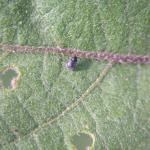Flea Beetle, Solanaceous
Epitrix fuscula
Epitrix cucumeris
From the perspective of a farmer surveying the crops, different types of flea beetles do not look much different – they all are small and black, they all hop away when you approach the plant, and they all make small round holes in the leaves. When eggplant, tomato and potatoes are hit hard by flea beetles, the damage is usually caused by the potato flea beetle, Epitrix cucumeris. Another species, the eggplant flea beetle, looks very similar but is found in more southern areas. Both tomatoes and potatoes often grow fast enough to outpace the damage, but if their growth is delayed, flea beetle can slow their progress even further. Eggplant seedlings are slow to establish and can be quickly turned into a fine lace– with little chance of recovery. For protection of eggplant or tomato with row cover, place the cover, with hoops, immediately after transplanting and seal the edges well. For transplants that are not covered, scout twice weekly, and if damage is increasing, take action before it is too late. Damage is probably the best measure of these flea beetle populations, since they are difficult to count.
Identification:
Chunky and hairy. In contrast to crucifer flea beetle, the potato flea beetle is shorter and broader (more ‘chunky’), has a more pitted and hairy body surface, and is less shiny, though both are all black and about 1/8 inch long. They also have a distinctly different diet, as crucifer flea beetle feeds only on Brassica crops and weeds.
Life Cycle:
The life cycle is very similar to that of crucifer flea beetle: adult beetles spend the winter protected under leaf litter in field edges near the crop where they were feeding in late summer, and search out new food plants in the spring. In the early spring they feed on horse nettle, pokeweed or other solanaceous weeds until they move to eggplant, potato or tomato, where they feed until August. Eggs are laid in the soil, larvae feed on roots, and after a pupal stage in the soil, a new gen¬eration of adult beetles will emerge. These ‘summer adults’ feed and then move to a protected spot for the winter. Thus there two major flushes of adults – one in late May and early June, and the second from mid July to mid August.
Crop Injury:
Numerous tiny feeding "shot holes" can injure leaves and stunt or kill plants, especially seedlings. Feeding damage can occur at any stage.
Cultural Controls & Prevention:
Management practices include clean cultivation, crop rotation, removing or avoiding spring weed hosts, use of row covers, and applying spot treatments targeting eggplants along the field edges. Treat newly set transplants if they have 2 flea beetles per plant, seedlings 3" to 6" tall if they have greater than 4 beetles per plant, and plants over 6" tall if they have 8 beetles per plant. Full size plants rarely require treatment for flea beetles. Most insecticides registered to control CPB, including spinosad, will control FB.
For Current information on production methods (including varieties, spacing, seeding, and fertility), weed, disease, and insect management, please visit the New England Vegetable Management Guide website.
Crops that are affected by this insect:
The Center for Agriculture, Food and the Environment and UMass Extension are equal opportunity providers and employers, United States Department of Agriculture cooperating. Contact your local Extension office for information on disability accommodations. Contact the State Center Director’s Office if you have concerns related to discrimination, 413-545-4800 or see ag.umass.edu/civil-rights-information.
